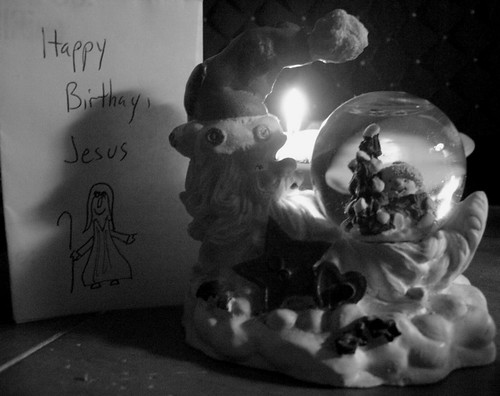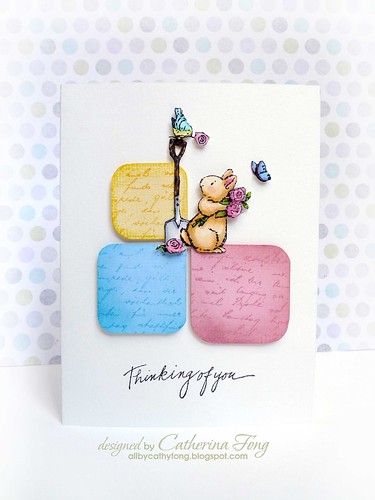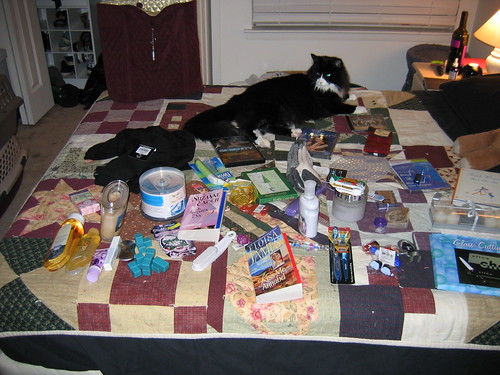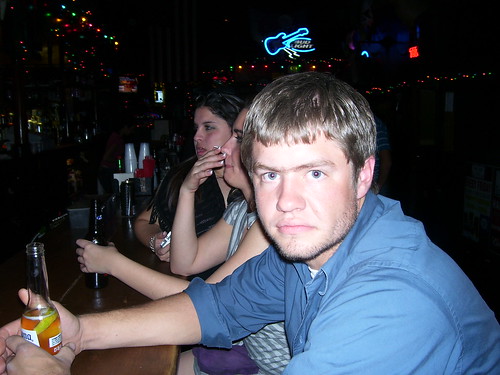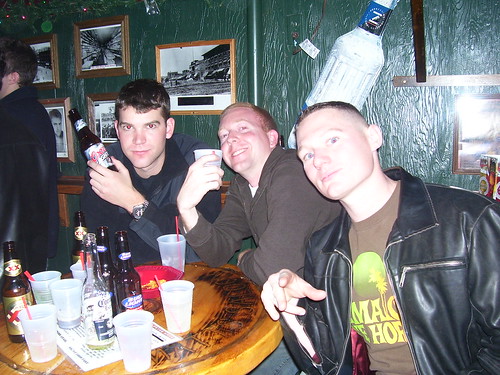100 views of Cuba, Dec 2011 - 47

Image by Ed Yourdon
This set consists of what I felt were the best 100 photos of the 3500+ images that I took in Cuba during a weeklong visit in December 2011.
More details later, as time permits...
***********************
Cuba. For today's generation of Americans, the notion of traveling to Cuba is probably like that of traveling to North Korea. It's off-limits, forbidden by the government -- and frankly, why would anyone bother? But for someone like me, who spent his childhood in the Cold War era of the 1950s, and who went off to college just after Castro took power, and just before the Bay of Pigs and the Cuban missile crisis, the notion of traveling to Cuba has entirely different overtones.
And yet Cuba is only 90 miles away from Key West (as we were reminded so often in the 1960s), and its climate is presumably no different than a dozen of Caribbean islands I've visited over the years. Numerous friends have made quasi-legal trips to Cuba over the years, flying in from Canada or Mexico, and they've all returned with fabulous pictures and great stories of a vibrant, colorful country. So, when the folks at the Santa Fe Photographic Workshops sent out a notice in November 2011, announcing a series of photo workshops in Havana, we couldn't resist the temptation to sign up.
Getting into Cuba turned out to be trivial: an overnight stay in Miami, a 45-minute chartered flight operated by American Airlines, and customs/immigration formalities that turned out to be cursory or non-existent. By mid-afternoon, our group was checked into the Parque Central Hotel in downtown Havana -- where the rooms were spacious, the service was friendly, the food was reasonably tasty, the rum was delicious, and the Internet was … well, slow and expensive.
We had been warned that that some of our American conveniences -- like credit cards -- would not be available, and we were prepared for a fairly spartan week. But no matter how prepared we might have been intellectually, it takes a while to adjust to a land with no Skype, no Blackberry service, no iPhone service, no phone-based Twitter, Facebook, or Google+. I was perfectly happy that there were no Burger Kings, no Pizza Huts, no Wendys, no Starbuck's, and MacDonalds. There was Coke (classic), but no Diet Coke (or Coke Light). There were also no police sirens, no ambulance sirens, and no church bells. There were no iPods, and consequently no evidence of people plugged into their music via the thin white earplugs that Apple supplies with their devices. No iPads, no Kindles, no Nooks, no … well, you get the picture. (It's also worth noting that, with U.S. tourists now beginning to enter the country in larger numbers, Cuba seems to be on the cusp of a "modern" invasion; if I come back here in a couple years, I full expect to see Kentucky Fried Chicken outlets on every corner.)
But there were lots of friendly people in Havana, crowding the streets, peering out of windows and doorways, laughing and shouting and waving at friends and strangers alike. Everyone was well-dressed in clean clothes (the evidence of which could be seen in the endless lines of clothing hanging from laundry lines strung from wall to wall, everywhere); but there were no designer jeans, no fancy shoes, no heavy jewelry, and no sign of ostentatious clothing of any kind. Like some other developing countries, the people were sometimes a little too friendly -- constantly offering a taxi ride, a pedicab ride, a small exchange of the "official" currency (convertible pesos, or "cuqs") for the "local" currency (pesos), a great meal or a great drink at a nearby restaurant or bar, a haircut, a manicure, or just a little … umm, well, friendship (offers for which ran the gamut of "señor" to "amigo" to "my friend"). On the street, you often felt you were in the land of the hustle; but if you smiled, shook your head, and politely said, "no," people generally smiled and back off.
As for the photography: well, I was in one of three different workshop groups, each of which had roughly a dozen participants. The three dozen individual photographers were well equipped with all of the latest Nikon and Canon gear, and they generally focused on a handful of subjects: buildings and architecture, ballet practice sessions, cockfights, boxing matches, rodeos, fishing villages, old cars, interiors of people's homes, street scenes, and people. Lots of people. As in every other part of the world I've visited, the people were the most interesting. We saw young and old, men and women, boisterous children, grizzled elders, police officers, bus drivers, and people of almost every conceivable race.
The streets were clean, though not spotless; and the streets were jammed, with bicycles and motorbikes and pedi-cabs, taxis, buses, horse-and-carriages, pedestrians, dogs (LOTS of dogs, many sleeping peacefully in the middle of a sidewalk), and even a few people on roller skates. And, as anyone who has seen photos of Havana knows, there were lots and lots and LOTS of old cars. Plymouths, Pontiacs, Dodges, Buicks, and Chevys, along with the occasional Cadillac. A few were old and rusted, but most had been renovated, repaired, and repainted -- often in garishly bright colors from every spectrum of the rainbow. Cherry pink, fire-engine red, Sunkist orange, lime green, turquoise and every shade of blue, orange, brown, and a lot more that I've probably forgotten. All of us in the photo workshop succumbed to the temptation to photograph the cars when we first arrived … but they were everywhere, every day, wherever we went, and eventually we all suffered from sensory overload. (For what it's worth, one of our workshop colleagues had visited Cuba eight years ago, and told us that at the time, there were only old cars in sight; now roughly half of the cars are more-or-less modern Kia's Audis, Russian Ladas, and other "generic" compact cars.)
The one thing I wasn't prepared for in Havana was the sense of decay: almost no modern buildings, no skyscrapers, and very little evidence of renovation. There were several monstrous, ugly, vintage-1950s buildings that oozed "Russia" from every pore. But the rest of the buildings date back to the 40s, the 30s, the 20s, or even the turn of the last century. Some were crumbling, some were just facades; some showed evidence of the kind of salt-water erosion that one sees near the ocean. But many simply looked old and decrepit, with peeling paint and broken stones, like the run-down buildings in whatever slum you're familiar with in North America. One has a very strong sense of a city that was vibrant and beautiful all during the last half of the 19th century, and the first half of the 20th century -- and then time stopped dead in its tracks.
Why that happened, and what's being done about it, is something I didn't have a chance to explore; there was a general reluctance to discuss politics in great detail. Some of Havana looks like the less-prosperous regions of other Caribbean towns; and some of it is presumably the direct and/or indirect result of a half-century of U.S. embargo. But some of it seems to be the result of the collapse of the Soviet Union in the early 1990s, and the subsequent collapse of foreign aid that Cuba depended upon.
As for my own photos: I did not attend the ballet practice sessions, nor did I see the rodeo. I did see some interesting graffiti on a few walls, which I photographed; but for some reason, I missed almost all of the numerous political billboards and stylized paintings of Che Guevera on buildings and walls. What I focused on instead was the "street scenes" of people and buildings, which will hopefully give you a sense of what the place is like.
Enjoy!
100 views of Cuba, Dec 2011 - 17

Image by Ed Yourdon
This set consists of what I felt were the best 100 photos of the 3500+ images that I took in Cuba during a weeklong visit in December 2011.
More details later, as time permits…
***********************
Cuba. For today's generation of Americans, the notion of traveling to Cuba is probably like that of traveling to North Korea. It's off-limits, forbidden by the government -- and frankly, why would anyone bother? But for someone like me, who spent his childhood in the Cold War era of the 1950s, and who went off to college just after Castro took power, and just before the Bay of Pigs and the Cuban missile crisis, the notion of traveling to Cuba has entirely different overtones.
And yet Cuba is only 90 miles away from Key West (as we were reminded so often in the 1960s), and its climate is presumably no different than a dozen of Caribbean islands I've visited over the years. Numerous friends have made quasi-legal trips to Cuba over the years, flying in from Canada or Mexico, and they've all returned with fabulous pictures and great stories of a vibrant, colorful country. So, when the folks at the Santa Fe Photographic Workshops sent out a notice in November 2011, announcing a series of photo workshops in Havana, we couldn't resist the temptation to sign up.
Getting into Cuba turned out to be trivial: an overnight stay in Miami, a 45-minute chartered flight operated by American Airlines, and customs/immigration formalities that turned out to be cursory or non-existent. By mid-afternoon, our group was checked into the Parque Central Hotel in downtown Havana -- where the rooms were spacious, the service was friendly, the food was reasonably tasty, the rum was delicious, and the Internet was … well, slow and expensive.
We had been warned that that some of our American conveniences -- like credit cards -- would not be available, and we were prepared for a fairly spartan week. But no matter how prepared we might have been intellectually, it takes a while to adjust to a land with no Skype, no Blackberry service, no iPhone service, no phone-based Twitter, Facebook, or Google+. I was perfectly happy that there were no Burger Kings, no Pizza Huts, no Wendys, no Starbuck's, and MacDonalds. There was Coke (classic), but no Diet Coke (or Coke Light). There were also no police sirens, no ambulance sirens, and no church bells. There were no iPods, and consequently no evidence of people plugged into their music via the thin white earplugs that Apple supplies with their devices. No iPads, no Kindles, no Nooks, no … well, you get the picture. (It's also worth noting that, with U.S. tourists now beginning to enter the country in larger numbers, Cuba seems to be on the cusp of a "modern" invasion; if I come back here in a couple years, I full expect to see Kentucky Fried Chicken outlets on every corner.)
But there were lots of friendly people in Havana, crowding the streets, peering out of windows and doorways, laughing and shouting and waving at friends and strangers alike. Everyone was well-dressed in clean clothes (the evidence of which could be seen in the endless lines of clothing hanging from laundry lines strung from wall to wall, everywhere); but there were no designer jeans, no fancy shoes, no heavy jewelry, and no sign of ostentatious clothing of any kind. Like some other developing countries, the people were sometimes a little too friendly -- constantly offering a taxi ride, a pedicab ride, a small exchange of the "official" currency (convertible pesos, or "cuqs") for the "local" currency (pesos), a great meal or a great drink at a nearby restaurant or bar, a haircut, a manicure, or just a little … umm, well, friendship (offers for which ran the gamut of "señor" to "amigo" to "my friend"). On the street, you often felt you were in the land of the hustle; but if you smiled, shook your head, and politely said, "no," people generally smiled and back off.
As for the photography: well, I was in one of three different workshop groups, each of which had roughly a dozen participants. The three dozen individual photographers were well equipped with all of the latest Nikon and Canon gear, and they generally focused on a handful of subjects: buildings and architecture, ballet practice sessions, cockfights, boxing matches, rodeos, fishing villages, old cars, interiors of people's homes, street scenes, and people. Lots of people. As in every other part of the world I've visited, the people were the most interesting. We saw young and old, men and women, boisterous children, grizzled elders, police officers, bus drivers, and people of almost every conceivable race.
The streets were clean, though not spotless; and the streets were jammed, with bicycles and motorbikes and pedi-cabs, taxis, buses, horse-and-carriages, pedestrians, dogs (LOTS of dogs, many sleeping peacefully in the middle of a sidewalk), and even a few people on roller skates. And, as anyone who has seen photos of Havana knows, there were lots and lots and LOTS of old cars. Plymouths, Pontiacs, Dodges, Buicks, and Chevys, along with the occasional Cadillac. A few were old and rusted, but most had been renovated, repaired, and repainted -- often in garishly bright colors from every spectrum of the rainbow. Cherry pink, fire-engine red, Sunkist orange, lime green, turquoise and every shade of blue, orange, brown, and a lot more that I've probably forgotten. All of us in the photo workshop succumbed to the temptation to photograph the cars when we first arrived … but they were everywhere, every day, wherever we went, and eventually we all suffered from sensory overload. (For what it's worth, one of our workshop colleagues had visited Cuba eight years ago, and told us that at the time, there were only old cars in sight; now roughly half of the cars are more-or-less modern Kia's Audis, Russian Ladas, and other "generic" compact cars.)
The one thing I wasn't prepared for in Havana was the sense of decay: almost no modern buildings, no skyscrapers, and very little evidence of renovation. There were several monstrous, ugly, vintage-1950s buildings that oozed "Russia" from every pore. But the rest of the buildings date back to the 40s, the 30s, the 20s, or even the turn of the last century. Some were crumbling, some were just facades; some showed evidence of the kind of salt-water erosion that one sees near the ocean. But many simply looked old and decrepit, with peeling paint and broken stones, like the run-down buildings in whatever slum you're familiar with in North America. One has a very strong sense of a city that was vibrant and beautiful all during the last half of the 19th century, and the first half of the 20th century -- and then time stopped dead in its tracks.
Why that happened, and what's being done about it, is something I didn't have a chance to explore; there was a general reluctance to discuss politics in great detail. Some of Havana looks like the less-prosperous regions of other Caribbean towns; and some of it is presumably the direct and/or indirect result of a half-century of U.S. embargo. But some of it seems to be the result of the collapse of the Soviet Union in the early 1990s, and the subsequent collapse of foreign aid that Cuba depended upon.
As for my own photos: I did not attend the ballet practice sessions, nor did I see the rodeo. I did see some interesting graffiti on a few walls, which I photographed; but for some reason, I missed almost all of the numerous political billboards and stylized paintings of Che Guevera on buildings and walls. What I focused on instead was the "street scenes" of people and buildings, which will hopefully give you a sense of what the place is like.
Enjoy!
100 views of Cuba, Dec 2011 - 25

Image by Ed Yourdon
This set consists of what I felt were the best 100 photos of the 3500+ images that I took in Cuba during a weeklong visit in December 2011.
More details later, as time permits…
***********************
Cuba. For today's generation of Americans, the notion of traveling to Cuba is probably like that of traveling to North Korea. It's off-limits, forbidden by the government -- and frankly, why would anyone bother? But for someone like me, who spent his childhood in the Cold War era of the 1950s, and who went off to college just after Castro took power, and just before the Bay of Pigs and the Cuban missile crisis, the notion of traveling to Cuba has entirely different overtones.
And yet Cuba is only 90 miles away from Key West (as we were reminded so often in the 1960s), and its climate is presumably no different than a dozen of Caribbean islands I've visited over the years. Numerous friends have made quasi-legal trips to Cuba over the years, flying in from Canada or Mexico, and they've all returned with fabulous pictures and great stories of a vibrant, colorful country. So, when the folks at the Santa Fe Photographic Workshops sent out a notice in November 2011, announcing a series of photo workshops in Havana, we couldn't resist the temptation to sign up.
Getting into Cuba turned out to be trivial: an overnight stay in Miami, a 45-minute chartered flight operated by American Airlines, and customs/immigration formalities that turned out to be cursory or non-existent. By mid-afternoon, our group was checked into the Parque Central Hotel in downtown Havana -- where the rooms were spacious, the service was friendly, the food was reasonably tasty, the rum was delicious, and the Internet was … well, slow and expensive.
We had been warned that that some of our American conveniences -- like credit cards -- would not be available, and we were prepared for a fairly spartan week. But no matter how prepared we might have been intellectually, it takes a while to adjust to a land with no Skype, no Blackberry service, no iPhone service, no phone-based Twitter, Facebook, or Google+. I was perfectly happy that there were no Burger Kings, no Pizza Huts, no Wendys, no Starbuck's, and MacDonalds. There was Coke (classic), but no Diet Coke (or Coke Light). There were also no police sirens, no ambulance sirens, and no church bells. There were no iPods, and consequently no evidence of people plugged into their music via the thin white earplugs that Apple supplies with their devices. No iPads, no Kindles, no Nooks, no … well, you get the picture. (It's also worth noting that, with U.S. tourists now beginning to enter the country in larger numbers, Cuba seems to be on the cusp of a "modern" invasion; if I come back here in a couple years, I full expect to see Kentucky Fried Chicken outlets on every corner.)
But there were lots of friendly people in Havana, crowding the streets, peering out of windows and doorways, laughing and shouting and waving at friends and strangers alike. Everyone was well-dressed in clean clothes (the evidence of which could be seen in the endless lines of clothing hanging from laundry lines strung from wall to wall, everywhere); but there were no designer jeans, no fancy shoes, no heavy jewelry, and no sign of ostentatious clothing of any kind. Like some other developing countries, the people were sometimes a little too friendly -- constantly offering a taxi ride, a pedicab ride, a small exchange of the "official" currency (convertible pesos, or "cuqs") for the "local" currency (pesos), a great meal or a great drink at a nearby restaurant or bar, a haircut, a manicure, or just a little … umm, well, friendship (offers for which ran the gamut of "señor" to "amigo" to "my friend"). On the street, you often felt you were in the land of the hustle; but if you smiled, shook your head, and politely said, "no," people generally smiled and back off.
As for the photography: well, I was in one of three different workshop groups, each of which had roughly a dozen participants. The three dozen individual photographers were well equipped with all of the latest Nikon and Canon gear, and they generally focused on a handful of subjects: buildings and architecture, ballet practice sessions, cockfights, boxing matches, rodeos, fishing villages, old cars, interiors of people's homes, street scenes, and people. Lots of people. As in every other part of the world I've visited, the people were the most interesting. We saw young and old, men and women, boisterous children, grizzled elders, police officers, bus drivers, and people of almost every conceivable race.
The streets were clean, though not spotless; and the streets were jammed, with bicycles and motorbikes and pedi-cabs, taxis, buses, horse-and-carriages, pedestrians, dogs (LOTS of dogs, many sleeping peacefully in the middle of a sidewalk), and even a few people on roller skates. And, as anyone who has seen photos of Havana knows, there were lots and lots and LOTS of old cars. Plymouths, Pontiacs, Dodges, Buicks, and Chevys, along with the occasional Cadillac. A few were old and rusted, but most had been renovated, repaired, and repainted -- often in garishly bright colors from every spectrum of the rainbow. Cherry pink, fire-engine red, Sunkist orange, lime green, turquoise and every shade of blue, orange, brown, and a lot more that I've probably forgotten. All of us in the photo workshop succumbed to the temptation to photograph the cars when we first arrived … but they were everywhere, every day, wherever we went, and eventually we all suffered from sensory overload. (For what it's worth, one of our workshop colleagues had visited Cuba eight years ago, and told us that at the time, there were only old cars in sight; now roughly half of the cars are more-or-less modern Kia's Audis, Russian Ladas, and other "generic" compact cars.)
The one thing I wasn't prepared for in Havana was the sense of decay: almost no modern buildings, no skyscrapers, and very little evidence of renovation. There were several monstrous, ugly, vintage-1950s buildings that oozed "Russia" from every pore. But the rest of the buildings date back to the 40s, the 30s, the 20s, or even the turn of the last century. Some were crumbling, some were just facades; some showed evidence of the kind of salt-water erosion that one sees near the ocean. But many simply looked old and decrepit, with peeling paint and broken stones, like the run-down buildings in whatever slum you're familiar with in North America. One has a very strong sense of a city that was vibrant and beautiful all during the last half of the 19th century, and the first half of the 20th century -- and then time stopped dead in its tracks.
Why that happened, and what's being done about it, is something I didn't have a chance to explore; there was a general reluctance to discuss politics in great detail. Some of Havana looks like the less-prosperous regions of other Caribbean towns; and some of it is presumably the direct and/or indirect result of a half-century of U.S. embargo. But some of it seems to be the result of the collapse of the Soviet Union in the early 1990s, and the subsequent collapse of foreign aid that Cuba depended upon.
As for my own photos: I did not attend the ballet practice sessions, nor did I see the rodeo. I did see some interesting graffiti on a few walls, which I photographed; but for some reason, I missed almost all of the numerous political billboards and stylized paintings of Che Guevera on buildings and walls. What I focused on instead was the "street scenes" of people and buildings, which will hopefully give you a sense of what the place is like.
Enjoy!
100 views of Cuba, Dec 2011 - 43

Image by Ed Yourdon
This set consists of what I felt were the best 100 photos of the 3500+ images that I took in Cuba during a weeklong visit in December 2011.
More details later, as time permits...
***********************
Cuba. For today's generation of Americans, the notion of traveling to Cuba is probably like that of traveling to North Korea. It's off-limits, forbidden by the government -- and frankly, why would anyone bother? But for someone like me, who spent his childhood in the Cold War era of the 1950s, and who went off to college just after Castro took power, and just before the Bay of Pigs and the Cuban missile crisis, the notion of traveling to Cuba has entirely different overtones.
And yet Cuba is only 90 miles away from Key West (as we were reminded so often in the 1960s), and its climate is presumably no different than a dozen of Caribbean islands I've visited over the years. Numerous friends have made quasi-legal trips to Cuba over the years, flying in from Canada or Mexico, and they've all returned with fabulous pictures and great stories of a vibrant, colorful country. So, when the folks at the Santa Fe Photographic Workshops sent out a notice in November 2011, announcing a series of photo workshops in Havana, we couldn't resist the temptation to sign up.
Getting into Cuba turned out to be trivial: an overnight stay in Miami, a 45-minute chartered flight operated by American Airlines, and customs/immigration formalities that turned out to be cursory or non-existent. By mid-afternoon, our group was checked into the Parque Central Hotel in downtown Havana -- where the rooms were spacious, the service was friendly, the food was reasonably tasty, the rum was delicious, and the Internet was … well, slow and expensive.
We had been warned that that some of our American conveniences -- like credit cards -- would not be available, and we were prepared for a fairly spartan week. But no matter how prepared we might have been intellectually, it takes a while to adjust to a land with no Skype, no Blackberry service, no iPhone service, no phone-based Twitter, Facebook, or Google+. I was perfectly happy that there were no Burger Kings, no Pizza Huts, no Wendys, no Starbuck's, and MacDonalds. There was Coke (classic), but no Diet Coke (or Coke Light). There were also no police sirens, no ambulance sirens, and no church bells. There were no iPods, and consequently no evidence of people plugged into their music via the thin white earplugs that Apple supplies with their devices. No iPads, no Kindles, no Nooks, no … well, you get the picture. (It's also worth noting that, with U.S. tourists now beginning to enter the country in larger numbers, Cuba seems to be on the cusp of a "modern" invasion; if I come back here in a couple years, I full expect to see Kentucky Fried Chicken outlets on every corner.)
But there were lots of friendly people in Havana, crowding the streets, peering out of windows and doorways, laughing and shouting and waving at friends and strangers alike. Everyone was well-dressed in clean clothes (the evidence of which could be seen in the endless lines of clothing hanging from laundry lines strung from wall to wall, everywhere); but there were no designer jeans, no fancy shoes, no heavy jewelry, and no sign of ostentatious clothing of any kind. Like some other developing countries, the people were sometimes a little too friendly -- constantly offering a taxi ride, a pedicab ride, a small exchange of the "official" currency (convertible pesos, or "cuqs") for the "local" currency (pesos), a great meal or a great drink at a nearby restaurant or bar, a haircut, a manicure, or just a little … umm, well, friendship (offers for which ran the gamut of "señor" to "amigo" to "my friend"). On the street, you often felt you were in the land of the hustle; but if you smiled, shook your head, and politely said, "no," people generally smiled and back off.
As for the photography: well, I was in one of three different workshop groups, each of which had roughly a dozen participants. The three dozen individual photographers were well equipped with all of the latest Nikon and Canon gear, and they generally focused on a handful of subjects: buildings and architecture, ballet practice sessions, cockfights, boxing matches, rodeos, fishing villages, old cars, interiors of people's homes, street scenes, and people. Lots of people. As in every other part of the world I've visited, the people were the most interesting. We saw young and old, men and women, boisterous children, grizzled elders, police officers, bus drivers, and people of almost every conceivable race.
The streets were clean, though not spotless; and the streets were jammed, with bicycles and motorbikes and pedi-cabs, taxis, buses, horse-and-carriages, pedestrians, dogs (LOTS of dogs, many sleeping peacefully in the middle of a sidewalk), and even a few people on roller skates. And, as anyone who has seen photos of Havana knows, there were lots and lots and LOTS of old cars. Plymouths, Pontiacs, Dodges, Buicks, and Chevys, along with the occasional Cadillac. A few were old and rusted, but most had been renovated, repaired, and repainted -- often in garishly bright colors from every spectrum of the rainbow. Cherry pink, fire-engine red, Sunkist orange, lime green, turquoise and every shade of blue, orange, brown, and a lot more that I've probably forgotten. All of us in the photo workshop succumbed to the temptation to photograph the cars when we first arrived … but they were everywhere, every day, wherever we went, and eventually we all suffered from sensory overload. (For what it's worth, one of our workshop colleagues had visited Cuba eight years ago, and told us that at the time, there were only old cars in sight; now roughly half of the cars are more-or-less modern Kia's Audis, Russian Ladas, and other "generic" compact cars.)
The one thing I wasn't prepared for in Havana was the sense of decay: almost no modern buildings, no skyscrapers, and very little evidence of renovation. There were several monstrous, ugly, vintage-1950s buildings that oozed "Russia" from every pore. But the rest of the buildings date back to the 40s, the 30s, the 20s, or even the turn of the last century. Some were crumbling, some were just facades; some showed evidence of the kind of salt-water erosion that one sees near the ocean. But many simply looked old and decrepit, with peeling paint and broken stones, like the run-down buildings in whatever slum you're familiar with in North America. One has a very strong sense of a city that was vibrant and beautiful all during the last half of the 19th century, and the first half of the 20th century -- and then time stopped dead in its tracks.
Why that happened, and what's being done about it, is something I didn't have a chance to explore; there was a general reluctance to discuss politics in great detail. Some of Havana looks like the less-prosperous regions of other Caribbean towns; and some of it is presumably the direct and/or indirect result of a half-century of U.S. embargo. But some of it seems to be the result of the collapse of the Soviet Union in the early 1990s, and the subsequent collapse of foreign aid that Cuba depended upon.
As for my own photos: I did not attend the ballet practice sessions, nor did I see the rodeo. I did see some interesting graffiti on a few walls, which I photographed; but for some reason, I missed almost all of the numerous political billboards and stylized paintings of Che Guevera on buildings and walls. What I focused on instead was the "street scenes" of people and buildings, which will hopefully give you a sense of what the place is like.
Enjoy!
100 views of Cuba, Dec 2011 - 18

Image by Ed Yourdon
This set consists of what I felt were the best 100 photos of the 3500+ images that I took in Cuba during a weeklong visit in December 2011.
More details later, as time permits…
***********************
Cuba. For today's generation of Americans, the notion of traveling to Cuba is probably like that of traveling to North Korea. It's off-limits, forbidden by the government -- and frankly, why would anyone bother? But for someone like me, who spent his childhood in the Cold War era of the 1950s, and who went off to college just after Castro took power, and just before the Bay of Pigs and the Cuban missile crisis, the notion of traveling to Cuba has entirely different overtones.
And yet Cuba is only 90 miles away from Key West (as we were reminded so often in the 1960s), and its climate is presumably no different than a dozen of Caribbean islands I've visited over the years. Numerous friends have made quasi-legal trips to Cuba over the years, flying in from Canada or Mexico, and they've all returned with fabulous pictures and great stories of a vibrant, colorful country. So, when the folks at the Santa Fe Photographic Workshops sent out a notice in November 2011, announcing a series of photo workshops in Havana, we couldn't resist the temptation to sign up.
Getting into Cuba turned out to be trivial: an overnight stay in Miami, a 45-minute chartered flight operated by American Airlines, and customs/immigration formalities that turned out to be cursory or non-existent. By mid-afternoon, our group was checked into the Parque Central Hotel in downtown Havana -- where the rooms were spacious, the service was friendly, the food was reasonably tasty, the rum was delicious, and the Internet was … well, slow and expensive.
We had been warned that that some of our American conveniences -- like credit cards -- would not be available, and we were prepared for a fairly spartan week. But no matter how prepared we might have been intellectually, it takes a while to adjust to a land with no Skype, no Blackberry service, no iPhone service, no phone-based Twitter, Facebook, or Google+. I was perfectly happy that there were no Burger Kings, no Pizza Huts, no Wendys, no Starbuck's, and MacDonalds. There was Coke (classic), but no Diet Coke (or Coke Light). There were also no police sirens, no ambulance sirens, and no church bells. There were no iPods, and consequently no evidence of people plugged into their music via the thin white earplugs that Apple supplies with their devices. No iPads, no Kindles, no Nooks, no … well, you get the picture. (It's also worth noting that, with U.S. tourists now beginning to enter the country in larger numbers, Cuba seems to be on the cusp of a "modern" invasion; if I come back here in a couple years, I full expect to see Kentucky Fried Chicken outlets on every corner.)
But there were lots of friendly people in Havana, crowding the streets, peering out of windows and doorways, laughing and shouting and waving at friends and strangers alike. Everyone was well-dressed in clean clothes (the evidence of which could be seen in the endless lines of clothing hanging from laundry lines strung from wall to wall, everywhere); but there were no designer jeans, no fancy shoes, no heavy jewelry, and no sign of ostentatious clothing of any kind. Like some other developing countries, the people were sometimes a little too friendly -- constantly offering a taxi ride, a pedicab ride, a small exchange of the "official" currency (convertible pesos, or "cuqs") for the "local" currency (pesos), a great meal or a great drink at a nearby restaurant or bar, a haircut, a manicure, or just a little … umm, well, friendship (offers for which ran the gamut of "señor" to "amigo" to "my friend"). On the street, you often felt you were in the land of the hustle; but if you smiled, shook your head, and politely said, "no," people generally smiled and back off.
As for the photography: well, I was in one of three different workshop groups, each of which had roughly a dozen participants. The three dozen individual photographers were well equipped with all of the latest Nikon and Canon gear, and they generally focused on a handful of subjects: buildings and architecture, ballet practice sessions, cockfights, boxing matches, rodeos, fishing villages, old cars, interiors of people's homes, street scenes, and people. Lots of people. As in every other part of the world I've visited, the people were the most interesting. We saw young and old, men and women, boisterous children, grizzled elders, police officers, bus drivers, and people of almost every conceivable race.
The streets were clean, though not spotless; and the streets were jammed, with bicycles and motorbikes and pedi-cabs, taxis, buses, horse-and-carriages, pedestrians, dogs (LOTS of dogs, many sleeping peacefully in the middle of a sidewalk), and even a few people on roller skates. And, as anyone who has seen photos of Havana knows, there were lots and lots and LOTS of old cars. Plymouths, Pontiacs, Dodges, Buicks, and Chevys, along with the occasional Cadillac. A few were old and rusted, but most had been renovated, repaired, and repainted -- often in garishly bright colors from every spectrum of the rainbow. Cherry pink, fire-engine red, Sunkist orange, lime green, turquoise and every shade of blue, orange, brown, and a lot more that I've probably forgotten. All of us in the photo workshop succumbed to the temptation to photograph the cars when we first arrived … but they were everywhere, every day, wherever we went, and eventually we all suffered from sensory overload. (For what it's worth, one of our workshop colleagues had visited Cuba eight years ago, and told us that at the time, there were only old cars in sight; now roughly half of the cars are more-or-less modern Kia's Audis, Russian Ladas, and other "generic" compact cars.)
The one thing I wasn't prepared for in Havana was the sense of decay: almost no modern buildings, no skyscrapers, and very little evidence of renovation. There were several monstrous, ugly, vintage-1950s buildings that oozed "Russia" from every pore. But the rest of the buildings date back to the 40s, the 30s, the 20s, or even the turn of the last century. Some were crumbling, some were just facades; some showed evidence of the kind of salt-water erosion that one sees near the ocean. But many simply looked old and decrepit, with peeling paint and broken stones, like the run-down buildings in whatever slum you're familiar with in North America. One has a very strong sense of a city that was vibrant and beautiful all during the last half of the 19th century, and the first half of the 20th century -- and then time stopped dead in its tracks.
Why that happened, and what's being done about it, is something I didn't have a chance to explore; there was a general reluctance to discuss politics in great detail. Some of Havana looks like the less-prosperous regions of other Caribbean towns; and some of it is presumably the direct and/or indirect result of a half-century of U.S. embargo. But some of it seems to be the result of the collapse of the Soviet Union in the early 1990s, and the subsequent collapse of foreign aid that Cuba depended upon.
As for my own photos: I did not attend the ballet practice sessions, nor did I see the rodeo. I did see some interesting graffiti on a few walls, which I photographed; but for some reason, I missed almost all of the numerous political billboards and stylized paintings of Che Guevera on buildings and walls. What I focused on instead was the "street scenes" of people and buildings, which will hopefully give you a sense of what the place is like.
Enjoy!
